Assignment:
1. Your mass is 50.0kg and you are on a flat surface. You are being pulled by a tow rope which makes an angle of 20.0 degrees with the horizontal. The tension in the rope is 650.N. You are pulled over a horizontal distance of 50.0m. The coefficient of kinetic friction is .0800. You are initially going 2.00m/s.

a. Draw an FBD of "you". Label the forces.
b. What is your initial kinetic energy?
c. How much work does the tension in the rope do?
d. Use the ΣFy to find the normal force. It will not equal the weight.
e. Find the frictional force.
f. How much work does friction do?
g. What is the net work?
h. What is your final kinetic energy?
i. What is your final speed?
2. The ski lift chair with passengers has a mass of 225kg. To get to the top of the mountain it travels a distance of 700.m at a 15.00 angle. The speed is constant at 5.00 m/s.
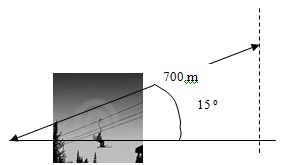
a. What is the total weight of chair with passengers?.
b. Use the definition of work to find the work done by gravity on the lift chair with passengers from the bottom to the top of the mountain? The distance is the 700.m shown in the diagram?
c. How much higher is the top of the mountain than the bottom? Hint: Use trig
d. What is the increase in potential energy of the chair and passengers?
e. What power is required to get the chair with passengers to the top?
3. At position 1 the potential energy is 0. In the picture above you are 12.0 m above position 1 traveling at a speed of 13.0m/s. Your mass is 50.0kg.

a. What is your total mechanical energy at the point in the picture?
b. With 0 friction what is your total energy at 3?
c. If your speed is 11.4 m/s at position 2, what height is 2 above the 0 level??
d. After position 1 the ground is flat. On this stretch of ground there is friction with a coefficient of kinetic friction = .15. What distance will you travel until you come to rest. Use the Work-Energy approach.
4. Goofy, mass = 55.0kg, is skiing 3.50 m/s west when he runs head on into a girl, mass = 45.0 kg, going east at 2.50 m/s. To decrease the impact he grabs the girl so they are stuck together.
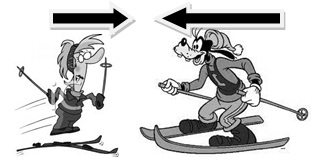
a. What is the total momentum (magnitude and direction) just before the collision?
b. What is the total momentum (magnitude and direction) right after the collision?
c. What is the final velocity of the goofy and the girl?
d. How much kinetic energy is lost in the collision?
5. For a break you decide to play a little hockey. The puck is 150.grams and is initially going left at 25.0 m/s. Use this as the negative direction. You smack the puck with a force of 1,900.N in the positive direction. Contact time is 5.00 ms.
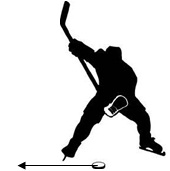
a. What is the initial momentum of the puck?
b. What is the impulse applied to the puck?
c. What is the change in the momentum of the puck?
d. What is the final momentum of the puck?
e. What is the final velocity of the puck?
6. Continuing your hockey playing you hit a puck so that it spins at 70.0 rpm (revolutions/min). The puck is a solid disk with a mass of 162 grams, a radius of 3.81 cm.
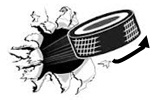
a. What is the moment of inertia of the puck in SI units?
b. Determine the torque necessary to bring the puck to rest in 0.100 seconds?
c. If the torque is produced by friction parallel(tangent) to the edge of the puck, what is the size of the frictional force?
7. The banners flying over the lodge weigh 15.0N and are attached so the center of mass is 1.80m from the wall. The horizontal pole itself weighs 40.0N and has its CM in the middle. It is hinged at the wall. The pole is2.40m long. A cable is attached to the end of the pole and makes a 30 degree angle with the horizontal.
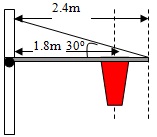
a. Draw an FBD of the horizontal pole. (don't forget the force components at the wall)
b. What is the tension in the cable?
c. What are the x and y components of the force at the wall?
8. In the evening you decide to watch a little ice skating. A skater starts a spin 1.2 rad/s. Her moment of inertia is 2.70kgm2.
a. If she pulls her arms in to decrease her moment of inertia to 1.8 kgm2, what will be her new angular speed?
b. If the tip of her nose is 15 cm from the axis of rotation what is its linear(tangential) speed of her nose tip with her arms pulled in?
9. In your race down the hill you make a sweeping curve of 20.0 m radius at a speed of 12.0 m/s. Your mass is 50.0kg.
a. What is your angular speed?
b. What radial (centripetal) force is required on your skis in order to make the turn?
c. If the curve forms a quarter of a circle, how long will it take to go through the turn?
10. This is a hypothetical problem. A super high (impossibly high) ski jump is built. The skier starts from rest at the top of this jump which is 620,000m above the surface of the earth'
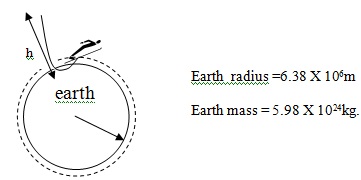
a. What is the skier's potential energy? Use g as if it remained constant
b. What is the increase in kinetic energy when the skier reaches the earth?
c. What speed will the skier have when she reaches the surface of the earth?
Bonus: What minimum height must the ski jump be so the skier can orbit the earth just above the earth's surface? Hint: the necessary speed can be found using concepts of uniform circular motion and universal gravity.
11. The ski lift chair shown above is 1.40 m wide. The center of gravity for the empty chair is in the middle and the chair itself weighs 233 N. The boy on the left has his center of gravity 0.400m from the left pole and weighs 280.N. The boy on the right is .350 m. from the right pole and weighs 320. N.
a. Draw a free body diagram of the chair seat.
b. Find the forces of the left post and the right post on the seat.